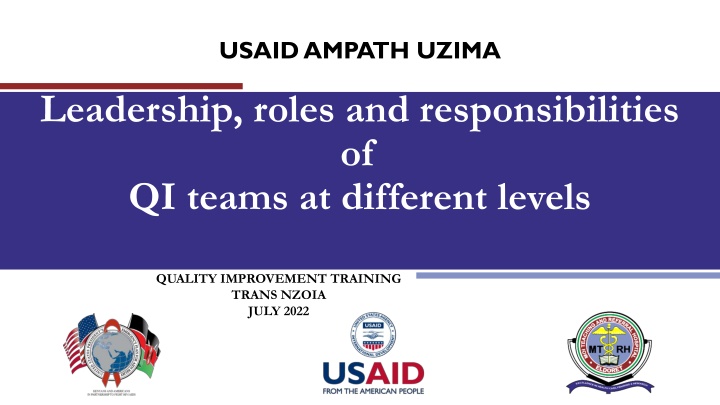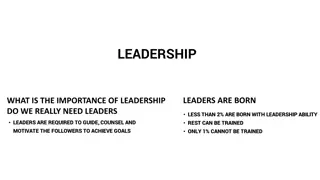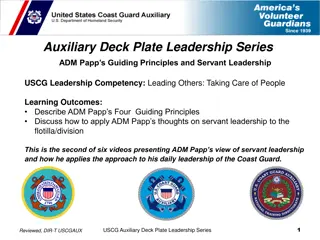
Leadership and Roles in Quality Improvement Teams - USAID AMPATH Uzima Training 2022
Explore the concept of leadership and the roles of leaders in Quality Improvement (QI) teams within the healthcare setting. Discover the attributes, qualities, and skills of effective leaders, along with the responsibilities of QI teams at different levels in the Kenyan health system. Join the USAID AMPATH Uzima training to enhance your understanding and capabilities in QI leadership.
Download Presentation

Please find below an Image/Link to download the presentation.
The content on the website is provided AS IS for your information and personal use only. It may not be sold, licensed, or shared on other websites without obtaining consent from the author. If you encounter any issues during the download, it is possible that the publisher has removed the file from their server.
You are allowed to download the files provided on this website for personal or commercial use, subject to the condition that they are used lawfully. All files are the property of their respective owners.
The content on the website is provided AS IS for your information and personal use only. It may not be sold, licensed, or shared on other websites without obtaining consent from the author.
E N D
Presentation Transcript
USAID AMPATH UZIMA Leadership, roles and responsibilities of QI teams at different levels QUALITY IMPROVEMENT TRAINING TRANS NZOIA JULY 2022
Session objectives By the end of this session, participants will be able to: Define the concept of leadership Mention attributes of a leader Describe the roles of a leader in QI in health care setting Identify the roles and responsibilities of QI teams at the different levels of the health system in Kenya USAID AMPATH Uzima
Definition of leadership Leadership is the art or process of influencing people so that they will strive willingly and enthusiastically toward the achievement of group goals Therefore: A Leader places him/herself before the group as they facilitate progress and inspire the group to accomplish for this case QI goals USAID AMPATH Uzima
What are the roles of a leader? Classroom exercise USAID AMPATH Uzima
Attributes of a leader Some of the attributes of a leader include: The ability to influence others Inspire others to achieve set objectives Have a shared vision Ability to direct USAID AMPATH Uzima
Quality of a leader Some qualities of a leader that are essential in most leadership styles Truthful Credible Approachable Confident Patient Focussed Accountable Communicator Persuasive Integrity Adaptive Any others? USAID AMPATH Uzima
Skills of a QI Leader Communication Clearly communicate the team's objectives and goals and actively listening Responsibility Self reflection, self awareness, open to criticism Commitment Keeping promises, following through Creativity Give room for innovation, encouraging non-traditional methods Positivity Developing a healthy work environment Feedback constructive feedback, removing micro-managing Trustworthiness Demonstrating integrity; building trust Motivation Encourage, praise where necessary, recognizing efforts Flexibility Accepting change; horizon scanning, problem solving Delegation Assign roles based on areas of strength USAID AMPATH Uzima
Roles of a leader in a QIT To guide a team of people to improve the quality of Health services To inspire and assure cooperation among the group To promote individual contribution towards achieving set objectives USAID AMPATH Uzima
Roles of a leader in QI in the health care setting There are four specific roles: A Support a systematic approach to QI B Communicate priorities C Support team members D Facilitate innovation and learning USAID AMPATH Uzima
Roles of a leader in QI (1) A. Support a systematic approach to QI Guidance Participate in QI team meetings Use data for decision-making Support QI changes Allocate resources to support implementation of changes USAID AMPATH Uzima
Roles of a leader in QI (2) B. Communicate priorities Develop and reinforce a sense of common purpose Clarify the goals and priorities Prioritization of areas for improvement Facilitate ongoing dialogue between leader and team members on QI activities USAID AMPATH Uzima
Roles of a leader in QI (3) C. Supporting team members Guidance Re-assurance (instill hope on team members) Recognizing their quality efforts USAID AMPATH Uzima
Roles of a leader in QI (4) D. Facilitate innovation and learning QI introducing and testing changes Support staff as they learn new skills Create a safe environment for learning and for experimentation USAID AMPATH Uzima
What Leadership styles do you know? Classroom exercise USAID AMPATH Uzima
Inclusive Leadership What is inclusive leadership? Effective collaboration: They empower others, pay attention to diversity of thinking and psychological safety, and focus on team cohesion. Cultural intelligence: They are attentive to others cultures and adapt as required. Awareness of bias: They show awareness of personal blind spots, as well as flaws in the system, and work hard to ensure a meritocracy. Listen to understand Value contributions USAID AMPATH Uzima
TEAM ROLES AND RESPONSIBILITIES AT DIFFERENT LEVELS OF THE HEALTH CARE SYSTEM USAID AMPATH Uzima
Examples of Quality Management Teams Department of Quality standards and regulations. KQMH/eKQMH Committee of experts at NASCOP. QI leadership in HIV programming. KHQIF framework COUNTY teams leadership Existence? Active? Your Role? Implemetors of policies from TOP Existence? Active? Your Role? WITs (MCH, OPD etc..) USAID AMPATH Uzima
Tasks across all levels Teams are responsible for: Goal setting, Activity planning, Implementation Roll out, and Program evaluation at their respective levels. Onward reporting of findings and data to the next level. Annual goals will be based on national goals and strategies, and informed by prior year performances. Each team will have a team leader. USAID AMPATH Uzima
National QM TWG Policy development guiding implementation of QM Periodic review of the health indicators, training material and curricula Resource mobilization Coordination of implementing partners on QI activities Provision of technical assistance to County QM teams Training and mentorship of staff Monitoring and evaluation of National QM program National level environmental scanning and identification of emerging trends for influencing policy Representation of Health interests on the national QM TWG Scale up of best practices in Health care QM and CQI USAID AMPATH Uzima
County QM Committee Adaptation of national policies guiding implementation of QI Establishment and support of reporting systems Capacity building of sub-county and facility staff Training, Supportive supervision and mentorship of county and facility staff Resource mobilization at county level Coordination of Health care implementing partners on QI activities. Monitoring and evaluation of the County QM program Oversight for expansion and support of Health care QI across counties County level environmental scanning and identification of emerging trends for influencing policy Scale up of best practices in Health care QM and CQI USAID AMPATH Uzima
Facility Quality Improvement Team Development of monthly, quarterly and annual QI plans for all services offered at respective facilities Identification of data sources for QM assessment, monitoring and evaluation Facility level implementation of national and county QI plans Training of facility staff on QI, CQI and QM Conducting periodic situation analysis and local environmental scanning Facility level M and E of QI plans including monthly review meetings Documentation of QI activities and onward reporting to county and national QM structures Oversight of QI activities and mentorship to facility departmental WITs, including WIT Resource mobilization and support for QI activities Representation of facility in external QI learning and sharing platforms USAID AMPATH Uzima
Work Improvement Teams Routine collection of QI performance data Direct monitoring of incremental changes brought about by 5-S and PDSA activities Client engagement and the obtaining of relevant feedback from patients and clients served Collation and submission of QI performance data to Facility QITs Provision of feedback to relevant stakeholders (including clients and the community) USAID AMPATH Uzima
What is needed to operationalize QI? USAID AMPATH Uzima
Key points The session focused on: Defining the concept of leadership The attributes of a leader Describing the roles of a leader Roles of leaders in QI Roles of QI teams at the different levels of the health system How leadership can support operationalization of QI USAID AMPATH Uzima
USAID AMPATH UZIMA THANK YOU info@ampathkenya.org | www.ampathkenya.org | @ampathkenya






















